Josh Stephens reviews two biographies of cities, The Dallas Myth: The Making and Unmaking of An American City and Reno’s Big Gamble: Image and Reputation in the Biggest Little City.
 Cities do not, generally, sleep with the wrong people. They do not lapse into drug-addled despair or plunge headlong into creative fervor, emerging as sex symbols, dictators, or captains of industry. Reasons, therefore, abound for why there is no section called ‘urbanographies‘ at least not in (what used to be) my local bookstore.
Cities do not, generally, sleep with the wrong people. They do not lapse into drug-addled despair or plunge headlong into creative fervor, emerging as sex symbols, dictators, or captains of industry. Reasons, therefore, abound for why there is no section called ‘urbanographies‘ at least not in (what used to be) my local bookstore.
Of course, cities do not build themselves, and whether their story begins with Romulus and Remus at the wolf mother's teat, or with Sheik al-Moktum's insane notion that one world is not enough, the forces that contribute to even the most modest settlement could fill volumes. But whether a city arises from autocratic whim, democratic stalemate, or back-room deals, the results of a city's history are, at any given moment, on full display. The most riveting version of a city's story is that which is told in asphalt and concrete, too real for words. And yet, it would be foolish to argue that anything as monumental as a city does not deserve a few books of its own.
The American West, which is not so new anymore, provides the setting for two worthy additions to the genre: The Dallas Myth, by Harvey Graff, and Reno's Big Gamble, by Alicia Barber. Both take on the challenge of chronicling cities that have never been centers of power, industry, or culture and yet are emblematic of American cities that emerged in the age of American unity, after the Civil War when railroads had knitted the nation together into a single culture and economy. Neither is riveting reading in and of itself, but, put together, they tell compelling tales about cities' efforts to invent, reinvent, and sell themselves.
Not so much a city as real estate ventures, Dallas was wrested from the frontier by city fathers who wanted to make a buck and needed a city to do so. Whereas "other places have histories," writes Graff, "Dallas has a record of economic expansion." An English professor, Graff mixes history with criticism to describe the stampede of developers and boosters who simply decided that Dallas should be a great city and had the gumption and capital to assert the "nearly uncontested domination of private interests over the public domain." Driven by a sincere, if crude, notion of progress, Dallas' boosters assigned all matter of slogan and, in Graff's analysis, "myths" to its otherwise characterless tracts.
These myths follow two themes: the first of Dallas' ascendant greatness and the second of its rugged individualism. Graff presents an entire page of slogans and nicknames – "The Metroplex," "Most American City," "the Business of Dallas is Business," "City with No History," and, most recently, "Build a Better Dallas," to name just a few. All of these slogans are meaningless in and of themselves, and yet "Dallas derives 'a certain character peculiar to itself' from 'its very lack of indigenous features.'" Graff notes that to this day Dallas' identity still rests in three arbitrary associations: a national tragedy, a sports team, and a TV show.
Led by real-life JR Ewings, Dallas grew according to the "Dallas Way," essentially a compact among business and political leaders to allow the city to grow into its myths before anyone noticed their falsity. This attitude gave rise to unfettered sprawl in the suburbs, but also a fixation on amenities in the urban core. City fathers have abided by the idea that "Dallas can be (or is) a great city if it has this element (building, district, institution, event, street life) because that's what great cities have." The result is a collection of fine museums, concert halls, airports, and, of course, athletic facilities.
The myth that is decidedly false is that which portrays it as a flush, harmonious city harboring naught but beatific Anglo families. With a striking skyline that could be seen from backyards that stretched off into the north Texas scrub, each suburban house is, according to Graff, a miniature South Fork Ranch, striving for the big cars, big hair, and easy new wealth of the idealized city. Meanwhile, Graff reminds us of that which most Metroplexers would care to forget: it is, in the words of celebrated Texas pundit Molly Ivins, the "most segregated city this side of Johannesburg." In the real Dallas, legions of African-Americans, Latino-Americans, and recent immigrants toil in neighborhoods perhaps not old or dense enough to be considered slums but which nonetheless prove that fantasies of the suburban metropolis do not come true so easily.
Whatever myths may prove false about Dallas, it turns out that the biggest myth about the world's "biggest little city" is in fact true: it was indeed the divorce capital of the United States. Add to that the other statutory source of Reno's renown – gambling – and you get perhaps the most arbitrary city of all time.
As Reno has likely been the object of more jokes than papers, Barber seizes on a rare opportunity in scholarship these days: that of taking the first crack at a heretofore un-studied topic. Reno's Big Gamble is the first authoritative, book-length history of the city. Her history follows a straightforward chronology, from desert outpost to "divorce capital" to the demi-metropolis of today. Barber's analysis identifies two key events in Reno's development: first, the arrival of Laura Corey, who stayed just long enough to free herself from her husband, a lout of a steel magnate; and, second, the staging of the 1910 prize fight between Jack Johnson and Jim Jeffries.
While plenty of its civic leaders envisioned a modest family town, Reno's early days invoke the notion of louche carpetbaggers taking up residency just long enough for their marriages to be terminated under Nevada law. Even so, Reno went out of its way to make luxury bloom in the high desert for a tide of women wealthy, discontented, and headstrong enough to take up residence in a cow town. "Each divorce-seeker functioned as an extended tourist, and a broad spectrum of residents stood to benefit from their presence...spread[ing] to clothing stores, restaurants, salons, pharmacies, and other business," writes Barber. "This commodification of Reno fit right in with the new landscape of consumption in the early twentieth century."
Reno's fortunes shifted, though, as divorce laws around loosened and Reno no longer could attract the rich and desperate. Meanwhile, the rise of Las Vegas in the 1950s threatened Reno's monopoly on destination gambling, and some of Reno's finest hotels and casinos failed. The most heartbreaking elements of Barber's account are the descriptions of historic buildings – each, according to Barber, the grandest, most important hotel, casino, or restaurant of its day – torn down, paved over, and assembled into the half-hearted destination hotels or vacant lots that dominate downtown Reno today, just barely beyond the blaze of the Vegas strip.
The salient historical question is, of course, what made some cities fail while others succeeded? Would Reno have prospered with a more aggressive civic coalition? Would Dallas have floundered if gambling had distracted its leaders?
And therein lies the trouble with the urbanography: the good parts -- the triumphs, such as Reno's downtown whitewater kayaking park on the Truckee River or Dallas' support of the arts – still stand, delivering a testimony more powerful than words can convey. But mourning in the silence of buildings lost and dreams deferred is both agonizing and pointless, like bemoaning a missed field goal or a lousy poker hand. Knowing that Reno was once steeped in grandeur or that Dallas should have paid more attention to its poor than to its slogans matters only if the next generation of urban leaders have the courage to erase it in favor of something more just, humane, pleasant, and sexy.
Josh Stephens is a freelance journalist based in Los Angeles and master's degree candidate at the Kennedy School of Government. He covers planning, transportation, and all manner of urbanism.

Planetizen Federal Action Tracker
A weekly monitor of how Trump’s orders and actions are impacting planners and planning in America.

Map: Where Senate Republicans Want to Sell Your Public Lands
For public land advocates, the Senate Republicans’ proposal to sell millions of acres of public land in the West is “the biggest fight of their careers.”

Restaurant Patios Were a Pandemic Win — Why Were They so Hard to Keep?
Social distancing requirements and changes in travel patterns prompted cities to pilot new uses for street and sidewalk space. Then it got complicated.

Platform Pilsner: Vancouver Transit Agency Releases... a Beer?
TransLink will receive a portion of every sale of the four-pack.

Toronto Weighs Cheaper Transit, Parking Hikes for Major Events
Special event rates would take effect during large festivals, sports games and concerts to ‘discourage driving, manage congestion and free up space for transit.”

Berlin to Consider Car-Free Zone Larger Than Manhattan
The area bound by the 22-mile Ringbahn would still allow 12 uses of a private automobile per year per person, and several other exemptions.
Urban Design for Planners 1: Software Tools
This six-course series explores essential urban design concepts using open source software and equips planners with the tools they need to participate fully in the urban design process.
Planning for Universal Design
Learn the tools for implementing Universal Design in planning regulations.
Heyer Gruel & Associates PA
JM Goldson LLC
Custer County Colorado
City of Camden Redevelopment Agency
City of Astoria
Transportation Research & Education Center (TREC) at Portland State University
Camden Redevelopment Agency
City of Claremont
Municipality of Princeton (NJ)


























 Buy on Amazon
Buy on Amazon
 Buy on Amazon
Buy on Amazon



